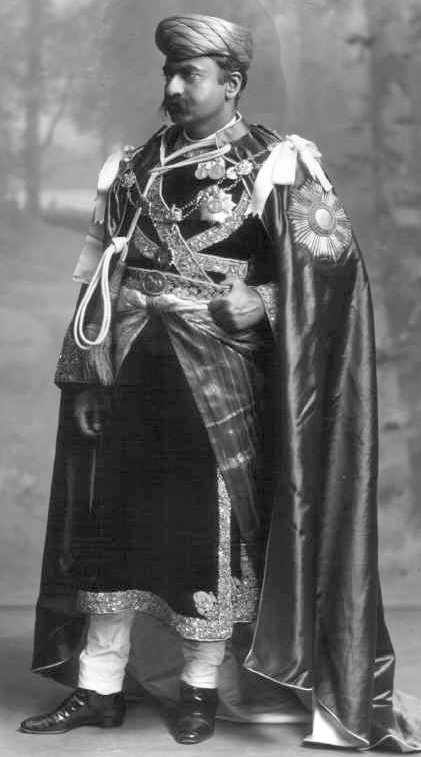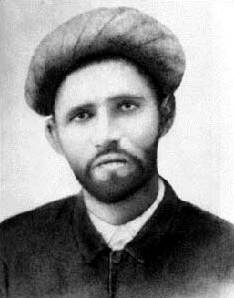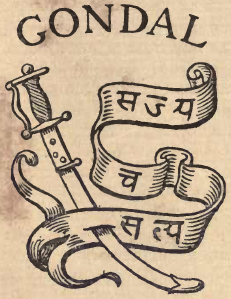|
Gondal, India
Gondal is a city of about 115,000 residents and a municipality of about 175,000 in the Rajkot district of the Indian state of Gujarat. Gondal State was one of the eight first-class princely states of Kathiawar Agency, Bombay Presidency in British India. Ruled by a Hindu Rajput dynasty of the Jadeja clan, the capital of the state was Gondal town. History Gondal is mentioned in texts like ''Ain-i-Akbari'' (written in the reign of Akbar) and ''Mirat-i-Ahmadi'' as a Vaghela state in Sorath ( Saurashtra). The Gondal State in Kathiawar Agency was founded in 1634 by Thakore Shri Kumbhoji I Meramanji from the Jadeja dynasty, who received Ardoi and other villages from his father Meramanji. Kumbhoki's fourth descendant, Kumbhoji IV, increased the size of the state by acquiring parganas such as Dhoraji, Upleta, and Sarai. [...More Info...] [...Related Items...] OR: [Wikipedia] [Google] [Baidu] |
Gujarat
Gujarat (, ) is a state along the western coast of India. Its coastline of about is the longest in the country, most of which lies on the Kathiawar peninsula. Gujarat is the fifth-largest Indian state by area, covering some ; and the ninth-most populous state, with a population of 60.4 million. It is bordered by Rajasthan to the northeast, Dadra and Nagar Haveli and Daman and Diu to the south, Maharashtra to the southeast, Madhya Pradesh to the east, and the Arabian Sea and the Pakistani province of Sindh to the west. Gujarat's capital city is Gandhinagar, while its largest city is Ahmedabad. The Gujaratis are indigenous to the state and their language, Gujarati, is the state's official language. The state encompasses 23 sites of the ancient Indus Valley civilisation (more than any other state). The most important sites are Lothal (the world's first dry dock), Dholavira (the fifth largest site), and Gola Dhoro (where 5 uncommon seals were found). Lothal ... [...More Info...] [...Related Items...] OR: [Wikipedia] [Google] [Baidu] |
Ardoi
Ardoi is a village in Kotda-Sangani Taluka of Rajkot district, Gujarat, India. History Ardoi was granted in appanage from Gondal State to Sangoji, founder of the Kotda Sangani estate, in about 1654-65 AD. Before this it was the original seat of the chieftain of Gondal. But when he acquired Gondal he moved his capital to there from Ardoi. The village has a tower on its eastern side. Geography It is situated about twelve miles north-east of Gondal and four miles north-west of Kotda and about twelve miles south of Rajkot. It is situated on a stream which flows into the Gondal river. The soil is good and the village lies only two miles to the east of the Rajkot-Gondal road. References This article incorporates text from a publication now in the public domain The public domain (PD) consists of all the creative work to which no exclusive intellectual property rights apply. Those rights may have expired, been forfeited, expressly waived, or may be inapplicable. Because thos ... [...More Info...] [...Related Items...] OR: [Wikipedia] [Google] [Baidu] |
Stone Carving
Stone carving is an activity where pieces of rough natural stone are shaped by the controlled removal of stone. Owing to the permanence of the material, stone work has survived which was created during our prehistory or past time. Work carried out by paleolithic societies to create stone tools is more often referred to as knapping. Stone carving that is done to produce lettering is more often referred to as lettering. The process of removing stone from the earth is called mining or quarrying. Stone carving is one of the processes which may be used by an artist when creating a sculpture. The term also refers to the activity of masons in dressing stone blocks for use in architecture, building or civil engineering. It is also a phrase used by archaeologists, historians, and anthropologists to describe the activity involved in making some types of petroglyphs. History The earliest known works of representational art are stone carvings. Often marks carved into rock or p ... [...More Info...] [...Related Items...] OR: [Wikipedia] [Google] [Baidu] |
Clock Tower In Gondal
A clock or a timepiece is a device used to measure and indicate time. The clock is one of the oldest human inventions, meeting the need to measure intervals of time shorter than the natural units such as the day, the lunar month and the year. Devices operating on several physical processes have been used over the millennia. Some predecessors to the modern clock may be considered as "clocks" that are based on movement in nature: A sundial shows the time by displaying the position of a shadow on a flat surface. There is a range of duration timers, a well-known example being the hourglass. Water clocks, along with the sundials, are possibly the oldest time-measuring instruments. A major advance occurred with the invention of the verge escapement, which made possible the first mechanical clocks around 1300 in Europe, which kept time with oscillating timekeepers like balance wheels., pp. 103–104., p. 31. Traditionally, in horology, the term ''clock'' was used for a strik ... [...More Info...] [...Related Items...] OR: [Wikipedia] [Google] [Baidu] |
Baroda State 1909
Vadodara (), also known as Baroda, is the second largest city in the Indian state of Gujarat. It serves as the administrative headquarters of the Vadodara district and is situated on the banks of the Vishwamitri River, from the state capital of Gandhinagar. The railway line and National Highway 8, which connect Delhi with Mumbai, pass through Vadodara. The city is named for its abundance of the Banyan (''Vad'') tree. Vadodara is also locally referred to as the ''Sanskari Nagari'' () and ''Kala Nagari'' () of India. The city is prominent for landmarks such as the Laxmi Vilas Palace, which served as the residence of the Maratha royal Gaekwad dynasty that ruled over Baroda State. It is also the home of the Maharaja Sayajirao University of Baroda. Etymology The city in one period was called Chandanavati after the rule of Chanda of the Dodiya Rajputs. The capital was also known as Virakshetra or Viravati (Land of Warriors). Later on, it was known as Vadpatraka or Vadodará, a ... [...More Info...] [...Related Items...] OR: [Wikipedia] [Google] [Baidu] |
Naulakha Palace 02
Naulakha (meaning "worth 9 lakh rupees" in Hindi language) may refer to: *Naulakha, Punjab, a historical village of Fatehgarh Sahib District, Punjab, India *Naulakha Pavilion, a century-arched chamber at Lahore Fort, Pakistan built for Shah Jahan in 1633 *Naulakha Palace, a ruined 17th-century palace in Gondal, India * Naulakha Mandir, Indian Hindu temples near Deoghar and Buxar *Naulakha (Rudyard Kipling House) Naulakha, also known as the Rudyard Kipling House, is a historic Shingle Style house on Kipling Road in Dummerston, Vermont, a few miles outside Brattleboro. The house was designated a National Historic Landmark in 1993 for its association with ... a house in Dummerston, Vermont, built for Rudyard Kipling in 1893 *''Naulakha Redux'', an album of songs of Rudyard Kipling works, recorded in 1997 by Roberts and Barrand * ''Naulakha'' (TV series), a 2018–2019 Pakistani drama serial Naulahka *'' The Naulahka: A Story of West and East'', a novel by Wolcott Balestier and Ru ... [...More Info...] [...Related Items...] OR: [Wikipedia] [Google] [Baidu] |
Muhammad Ali Jinnah
Muhammad Ali Jinnah (, ; born Mahomedali Jinnahbhai; 25 December 1876 – 11 September 1948) was a barrister, politician, and the founder of Pakistan. Jinnah served as the leader of the All-India Muslim League from 1913 until the inception of Pakistan on 14 August 1947, and then as the Dominion of Pakistan's first Governor-General of Pakistan, governor-general until his death. Born at Wazir Mansion in Karachi, Jinnah was trained as a barrister at Lincoln's Inn in London. Upon his return to British Raj, India, he enrolled at the Bombay High Court, and took an interest in national politics, which eventually replaced his legal practice. Jinnah rose to prominence in the Indian National Congress in the first two decades of the 20th century. In these early years of his political career, Jinnah advocated Hindu–Muslim unity, helping to shape the 1916 Lucknow Pact between the Congress and the All-India Muslim League, in which Jinnah had also become prominent. Jinnah beca ... [...More Info...] [...Related Items...] OR: [Wikipedia] [Google] [Baidu] |
Rajkot–Somnath Line
The Rajkot–Somnath line is a railway line connecting Jetalsar and Veraval. It covers a distance of in Gujarat. History The initial section from Veraval to Junagadh was started in 1880 by Junagadh Railway and opened to traffic in 1888. The line between Rajkot to Jetalsar was started in 1880 by Rajkot–Jetalsar Railway and opened to traffic in 1890. Rajkot-Junagadh-Veraval section was merged with Saurashtra Railway in April 1948. Saurashtra Railway was merged into Western Railway Western Railway may refer to: * Western Railway (Austria) * Hanoverian Western Railway, Germany * Western Railway zone, on Indian Railways * Württemberg Western Railway, Germany See also * Westbahn (other) * Western Railroad (disambigua ... on 5 November 1951. Gauge conversion of Rajkot–Veraval section was announced in 1996-97. Gauge conversion of Rajkot–Veraval has been completed in 2003. References {{DEFAULTSORT:Rajkot-Somnath line 1890 establishments in India Railway lines ... [...More Info...] [...Related Items...] OR: [Wikipedia] [Google] [Baidu] |
Viramgam–Okha Line
The Viramgam–Okha line is a railway passing through Gujarat State, in western India. Geography The Viramgam–Okha line passes through Central part of Gujarat connecting Surendranagar, Wankaner, Rajkot and Jamnagar. It covers a distance of in Gujarat. It is explained in detailed in sections: # Viramgam–Surendra Nagar section # Wankaner–Surendra Nagar section # Rajkot–Wankaner section History Viramgam–Okha section was laid by a number of Princely States and is initially a metre gauge line. Ahmedabad–Viramgam section was opened by Bombay, Baroda and Central India Railway by 1871 and was extended to Wadhwan by 1872. Surendra Nagar-Rajkot section was opened by Morvi State Railway in 1890. Rajkot-Jamnagar line was opened by 1897 and Jamnagar-Okha section was opened in 1922 by Jamnagar & Dwarka Railway. Rajkot-Junagadh-Veraval section was merged with Saurashtra Railway in April 1948. Saurashtra Railway was merged into Western Railway on 5 November 1951. Gauge convers ... [...More Info...] [...Related Items...] OR: [Wikipedia] [Google] [Baidu] |
Time (magazine)
''Time'' (stylized in all caps) is an American news magazine based in New York City. For nearly a century, it was published Weekly newspaper, weekly, but starting in March 2020 it transitioned to every other week. It was first published in New York City on March 3, 1923, and for many years it was run by its influential co-founder, Henry Luce. A European edition (''Time Europe'', formerly known as ''Time Atlantic'') is published in London and also covers the Middle East, Africa, and, since 2003, Latin America. An Asian edition (''Time Asia'') is based in Hong Kong. The South Pacific edition, which covers Australia, New Zealand, and the Pacific Islands, is based in Sydney. Since 2018, ''Time'' has been published by Time USA, LLC, owned by Marc Benioff, who acquired it from Meredith Corporation. History ''Time'' has been based in New York City since its first issue published on March 3, 1923, by Briton Hadden and Henry Luce. It was the first weekly news magazine in the United St ... [...More Info...] [...Related Items...] OR: [Wikipedia] [Google] [Baidu] |
Purdah
Pardah or purdah (from Hindi-Urdu , , meaning "curtain") is a religious and social practice of female seclusion prevalent among some Muslim and Hindu communities. It takes two forms: physical segregation of the sexes and the requirement that women cover their bodies so as to cover their skin and conceal their form. A woman who practices purdah can be referred to as or . The term ''purdah'' is sometimes applied to similar practices in other parts of the world. Practices that restricted women's mobility and behavior existed among all religious groups since ancient times and intensified with the arrival of Islam. By the 19th century, purdah became customary among Hindu elites. Purdah was not traditionally observed by lower-class women. Physical segregation within buildings is achieved with judicious use of walls, curtains, and screens. A woman's withdrawal into purdah usually restricts her personal, social and economic activities outside her home. The usual purdah garment worn is ... [...More Info...] [...Related Items...] OR: [Wikipedia] [Google] [Baidu] |
Bhagvatsinhji
Bhagvatsinhji (24 October 1865 – 9 March 1944) was the ruling Maharaja of the princely state of Gondal from 1869 till his death in 1944, upon which he was honoured with 11-gun salute. He was the only Maharaja to take a medical degree and other degrees. Early life Bhagvatsingh was born as ''Kumar Sri'' Bhagvatsinghji Sangramsinhji Sahib, Yuvaraja Sahib of Gondal, on 24 October 1865 at Dhoraji, the third and the youngest but only surviving son of Thakurani Bai Shri Monghiba Sahiba, daughter of Jhala Shri Rartansinhji Sahib of Minapur,Bhagvatsinghji Sangramsinhji ''''. the third wife of Thakore Sagramji II, the Thakore S ... [...More Info...] [...Related Items...] OR: [Wikipedia] [Google] [Baidu] |




.jpg)



